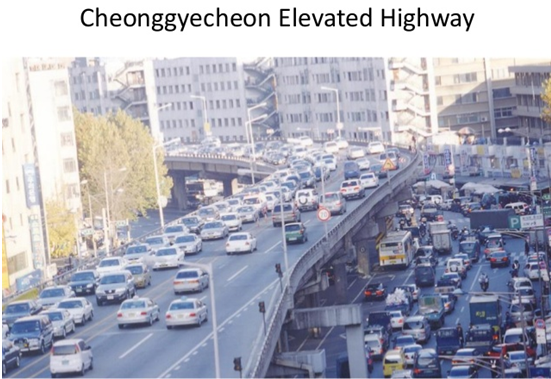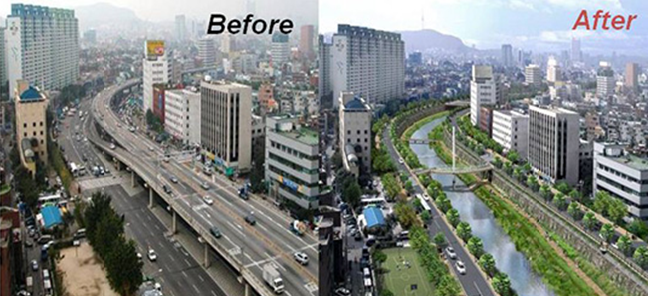LESS THANKS 1 (SEOUL 2002-2006)
Anyone who has watched the recent Who Who Millionaire program or who has surfed the web pages like Muong 18 would know that a girlfriend answered the wrong question: "What is the Han River?" Confused with the city X also has a romantic Han River flowing through, this girlfriend is the heart of the stonework of the keyboard hero of the country: "Back to school again," "Brain short," " The failure of the education of Vietnam "," That also do not know, it on Singapore, very much stupid "...
Mr. Bus was so proud after he finished answering the question that 99.99% of young people in the country think that this super easy (although his daughter who has Dr. America also can not answer ). After the visit to Curitiba, Mr. Jaime introduced him to the Traffic Communications Book in Seoul, Korea, initiated by the prestigious leader Lee Myung-bak. The content of the book is as follows:
a / Traffic situation in Seoul before reform: • On October 21, 1994, the Seongsu Bridge collapse across the Han River left 32 people dead; • On June 29, 1995, the 5-storey commercial center of Sampoong collapsed, causing 502 deaths and 937 injuries; These works were built during the period of ppali, ppali (rapid, rapid), the speed of development like the storm of Korea with a series of national works, expressways, ... built on a large scale, making it one of the four dragons in Asia, becoming the 11th economy in the world and third in Asia after Japan and Singapore. These bridge collapses and commercial centers are a wake-up call for the government and the people of South Korea on unsafe construction, with a greater emphasis on quality and corruption in the state apparatus. This is likened to the collapse of the build-up regime to which South Korea has been loyal for decades. So, when Lee Myung-bak, the former CEO of the Hyundai Construction Group, ran for Seoul's mayor in 2002, many of them objected to the return of a prosperous construction regime. in the past. And Mr. Lee proved the opposite.
Prior to the reform, there were a number of measures taken to improve the transportation system in Seoul such as the introduction of a bus lane (1986), the introduction of the Smart Traffic Card (1996) redesign of the bus route (1995-1997) or the development of the metro system (1998-2002) ... However, all of these reforms can not bring a new wind to deliver. In Seoul, the only breakthrough was the introduction of subsidies to private bus operators. The bus routes are very winding and very long (80km), mostly converging in some high traffic corridors, causing severe traffic congestion and low levels of SP services in many areas. And this situation has not improved.

(Nguồn: Slideshare https://www.slideshare.net/simrc/smart-and-sustainable-city-case-of-urban-transformation-of-seoul-myounggu-kang)
The core reason is that most planners tend to pursue incremental changes / improvements rather than a significant change. That is, they only deal temporarily with the difficulties existing individually rather than building a comprehensive picture. Planning became technical exercises, solving the problem in a hotspot at the urgent request at that time. Maintaining everything as status quo is a popular policy in the planning of many cities today. Thus, a government that sees change as imperative and determined to do so will ultimately be the key to making a dream city a reality.
b / Objectives and vision
Traffic reform is not the end, but it is just the beginning of the redevelopment of the central area that the mayor pursues. Seoul (2002-2006) is in the process of moving from development orientation to improving the quality of life of people and the importance of the ecosystem. For example, mayor Lee has dismantled two major highways and restored the Cheonggyecheon Stream covered by them for decades and converted the area into a central park. The Cheonggyecheon Rehabilitation Project has helped to develop ecosystems and recreational activities along the 3.6-mile-long corridor in central Seoul.

Cheong Gye Cheon, Seoul. Dr. Gyeng Chul Kim, Korea Transport Institute
The concrete highway in Cheonggyecheon, although still valid and even important in the city, has made the region less environmentally and aesthetically pleasing due to its crowded automobile. molding and air pollution. Now it has become an ideal destination for Seoul residents and tourists looking to experience the green ecosystem as well as investors and businessmen who want to be located in one of the most prosperous areas in the city. (The price of land in Cheonggyecheon increased by 30-50% within the 50m radius of the project). The project has shown that environmental and economic objectives can be simultaneously enhanced without destroying one another.
c / Choice of traffic solutions
However, the Cheonggyecheon recovery has been criticized for lack of alternative traffic alternatives for the two highways destroyed (168,000 cars will be affected). It would cause severe traffic congestion in other parts of the city and would only move from the Cheonggyecheon area to another area. Some advisers suggested Lee build tunnels like the Big Dig project in Boston but would take 10 years to complete. The mayor quickly vetoed the idea because "If a project takes too long to complete, it will cost two to three times. In addition, when completed faster, the surrounding area of the project will quickly be used for development and profit will begin to accrue earlier. "As a politician, the highways were not suitable. with Lee's personal development path.
Roadside charges such as those in Singapore and London are another option that Mr. Lee Myung-bak considers to reduce and control people's mobility needs in the central area. However, toll roads have "huge political risks" and "the mayor is very interested in the ability of people to accept his policies." "We know that if we take tolls on the freeway, we can manage the demand and have some money to subsidize and develop the public transport system," he said. This will seriously undermine people's support for our policies. "
The consultant team also evaluated an alternative by extending some existing routes and altering the traffic on some other routes. However, this solution will only bring about modest effects and "Instead of letting cars run across a network of routes, we recommend removing this network completely and making the bus faster. and more efficient than cars. " That is, converting the development goal to a bus that is not an auto upgrade and a road network. "Well, traffic is not a technical problem but a political one! There are so many choices, but to choose the right solution for the economic situation, cultural identity, politics of the city without conflicting with the personal priority of the leader is very difficult! " - Mr. Traffic.
(To be continued)
Lê Thị Thu Vân.
Dewey, O. F. (2016). Seoul: Transportation Reform as an enabler of urban regeneration. Retrieved on 4th April, 2017 from: https://static1.squarespace.com/static/5804efd7cd0f68e576ecd423/t/5807c5761b631bfd2b5433fd/1476904311224/Seoul+Case+2016.pdf
“Giao thông không phải là vấn đề kỹ thuật mà là là vấn đề chính trị” (Transport is not a technical, but a political issue)
Enrique Peñalosa
Cựu thị trưởng Bogotà, Thủ đô Colombia
Tóm tắt tiểu sử ngài Lee Myung-bak:
“Cuộc đời ông [Lee Myung-bak] có thể xem như là một kỳ tích: Từ một chú bé nhặt rác trở thành nhà lãnh đạo doanh nghiệp và rồi trở thành tổng thống với số phiếu ủng hộ cao nhất kể từ khi Hàn Quốc bắt đầu tiến trình dân chủ hóa từ thập niên 1980” (Wikipedia).
|
Năm
|
Nội dung
|
|
1941
|
Sinh tại Osaka, Nhật Bản
|
|
1945
|
Hồi hương Hàn Quốc cùng gia đình
|
|
1965
|
Tốt nghiệp khoa Quản trị kinh doanh, Đại học Korea tại Hàn Quốc. Vào làm việc ở Công ty Xây dựng Hyundai
|
|
1970
|
Giám đốc của Công ty Xây dựng Hyundai
|
|
1977~1992
|
Chủ tịch hội đồng quản trị của 10 công ty liên kết bao gồm cả Công ty Xây dựng Hyundai
|
|
1992
|
Rời khỏi Tập đoàn Hyundai
|
|
1992~1996
|
Ủy viên Quốc hội lần thứ 14 của Hàn Quốc
|
|
1996~1998
|
Ủy viên Quốc hội lần thứ 15 của Hàn Quốc
|
|
2002~2006
|
Thị trưởng Thành phố Seoul
|
|
2008~2013
|
Tổng thống lần thứ 17 của Hàn Quốc
|
(Nguồn: Wikipedia)